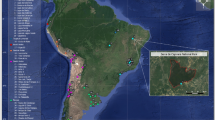Abstract
Taxonomic affiliation in Plio-Pleistocene fossil hominids is generally based on the analysis of cranial and dental material where species-specific characteristics are well recognised (Wood, 1991, 1992). With the exception of features such as the relatively long neck and small head in the australopithecine femur, taxon-specific features in the postcranial skeleton are largely unknown (Aiello and Dean, 1990). This situation is undoubtedly the result of the relative absence of associated skeletons in the Plio-Pleistocene fossil record and the general paucity of postcranial material. It follows that species-specific features in the postcranial skeleton have played only a secondary role in taxonomic studies and that it is often difficult to assign isolated postcranial fossils to specific species.
Access this chapter
Tax calculation will be finalised at checkout
Purchases are for personal use only
Preview
Unable to display preview. Download preview PDF.
Similar content being viewed by others
References
Aiello LC, and Dean MC (1990) An Introduction to Human Evolutionary Anatomy. London: Academic Press.
Aiello LC, and Wood BA (1994) Cranial variables as predictors of hominine body mass. Am. J. Phys. Anthropol., 95:409–426.
Bookstein FL (1991) Morphometric Tools for Landmark Data. Cambridge: Cambridge University Press.
Davis PR (1964) Hominid fossils from Bed I, Olduvai Gorge, Tanganyika. Nature 201:967–970.
Day MH (1976) Hominid postcranial material from Bed I, Olduvai Gorge. In G Isaac and E McCown (eds.): Human Origins. California: W.A. Benjamin, pp. 363–374.
Day MH (1978) Functional interpretations of the morphology of postcranial remains of early African hominids. In CJ Jolly (ed.): Early Hominids of Africa. London: Duckworth, pp. 311–345.
Jonsson K, Fredin HO, Cedgrlund CG, and Bauer M (1984) Width of the normal ankle joint. Acta Radiologica Diagnosis 25:147–149.
Harvey PH, Martin RD, and Clutton-Brock TH (1987) Life histories in comparative perspective. In BB Smuts, DL Cheney, RM Seyfarth, RW Wrangham, and TT Struhsaker (eds.): Primate Societies. Stuttgart: Thieme-Verlag, pp. 419–434.
Koenerink JJ, and van Doom AJ (1992) Surface shape and curvature scales. Image and Vision Computing, 10:557–565.
Leakey MD (1971) Olduvai Gorge: Excavations in Beds I and II, 1960–1963, Vol. 3. Cambridge: Cambridge University Press.
Leakey LSB, Tobias PV, and Napier JR (1964) A new species of the genus Homo from Olduvai Gorge. Nature, 202:7–9.
Marcus LF, Corti M, Loy A, Nayler GJP, and Slice DE (1996) Advances in Morphometrics. New York: Plenum.
Susman RL, and Stern JT Jr. (1982) Functional morphology of Homo habilis. Nature, 217:931–934.
Tobias PV (1991) Olduvai Gorge: The Skulls, Endocasts and Teeth of Homo habilis. Vol. 4. Cambridge: Cambridge University Press.
Wood BA (1991) Koobi Fora Research Project IV: Hominid Cranial Remains from Koobi Fora. Oxford: Clarendon.
Wood BA (1992) Origin and evolution of the genus Homo. Nature, 355:783–790.
Wood BA, Aiello LC, Wood C, and Key C (submitted) A technique for establishing the identity of “isolated” fossil hominid limb bones. Journal of Anatomy.
Wynarsky GT, and Greenwald AS (1983) Mathematical model of the human ankle joint. Journal of Biomechanics, 16:241–251.
Author information
Authors and Affiliations
Editor information
Editors and Affiliations
Rights and permissions
Copyright information
© 1998 Springer Science+Business Media New York
About this chapter
Cite this chapter
Aiello, L., Wood, B., Key, C., Wood, C. (1998). Laser Scanning and Paleoanthropology. In: Strasser, E., Fleagle, J.G., Rosenberger, A.L., McHenry, H.M. (eds) Primate Locomotion. Springer, Boston, MA. https://doi.org/10.1007/978-1-4899-0092-0_13
Download citation
DOI: https://doi.org/10.1007/978-1-4899-0092-0_13
Publisher Name: Springer, Boston, MA
Print ISBN: 978-1-4899-0094-4
Online ISBN: 978-1-4899-0092-0
eBook Packages: Springer Book Archive




